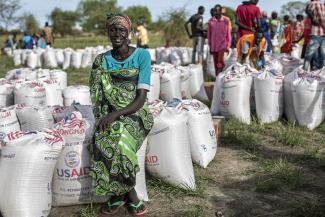
USAID leads international food assistance efforts within the U.S. government through its Bureau for Humanitarian Assistance (BHA). For more than 65 years, USAID has helped more than 60 million hungry people in nearly 60 countries every year, including refugees. During times of crisis when people face food insecurity or even the threat of starvation, USAID provides food assistance to the most vulnerable in the form of food, cash transfers or food vouchers. Learn more about our response modalities.
USAID provides emergency food assistance in several ways:
Emergency Food Security Program (EFSP)
USAID receives emergency food assistance resources through the International Disaster Assistance (IDA) account, authorized in the Foreign Assistance Act. IDA allows USAID to address food security emergencies through approaches that strengthen existing and functional local markets by purchasing food locally or from nearby countries and distributing to those most in need, or providing cash transfers for food and food vouchers so people can buy food of their choosing at local markets.
Title II
Title II of the Food for Peace Act primarily provides U.S. food to those suffering from hunger or starvation. Title II food commodities are grown in the United States by U.S. farmers and sent overseas to feed vulnerable populations in the poorest corners of the world.
The Bill Emerson Humanitarian Trust (BEHT)
The Bill Emerson Humanitarian Trust (BEHT) is a special authority in the Agriculture Improvement Act of 2018 (2018 Farm Bill) that allows USAID to respond to unanticipated food crises abroad, when other Title II resources are not available.
RELATED LINKS
- Partner With BHA
- Modalities for Emergency Food and Nutrition Assistance
- USAID Food Assistance Community Development Funds
- USAID Prepositioned Food Assistance Stocks
- Food Assistance Sector Update
- Nutrition Sector Update
